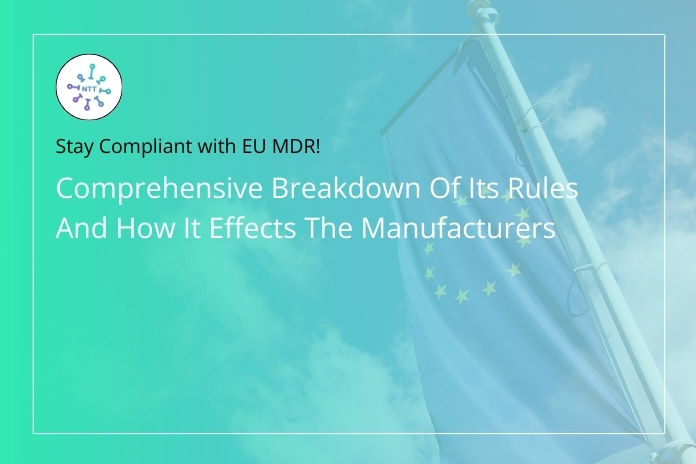The European Union Medical Device Regulation (EU MDR) (2017/745) sets out an extensive framework that regulates the manufacture and sale of medical devices in the EU. Enacted in 2017, the EU MDR superseded the erstwhile Medical
Devices Directive (MDD) (93/42/EEC) and the Active Implantable Medical Devices Directive (AIMDD) (90/385/EEC). The main goal of the EU MDR is to increase patient safety by enforcing rigorous standards upon the manufacturers
of medical devices.
Key Changes Introduced by EU MDR
The MDR came into force on 26th May 2017 and became applicable on 26th May 2021 in all EU member states. The EU MDR brought some major changes to the regulatory framework:
- Increased Scope: The regulation now covers a wider scope of products, including those that do not have a medical intent but share similar features with medical devices, like cosmetic implants and contact lenses.
- Redesignation of Devices:A large number of devices have been redesignated into higher-risk classes, which require more stringent assessment processes.
- Unique Device Identification (UDI): Each device is to be assigned a UDI by manufacturers, which facilitates better traceability in the supply chain.
- Clinical Evaluation: Greater emphasis on clinical data, under which manufacturers have to supply solid clinical evidence for the safety and performance of the devices.
- Post-Market Surveillance: Manufacturers need to establish good post-market surveillance systems to keep track of the performance of devices and report any adverse events.
CE Marking Under MDR
Acquiring the CE marking is a matter of law for placing medical devices on the EU market. The process of obtaining CE marking has become more rigorous under the EU MDR. Manufacturers are required to verify that their products conform
to the General Safety and Performance Requirements (GSPR) of the regulation.
This entails a careful conformity assessment, possibly involving the services of a Notified Body, particularly for higher-risk devices. CE marking shall be attached visibly, legibly, and permanently to the device or on its packaging
before it is made available for sale on the market.
Effects on Manufacturers
The adoption of the EU MDR has fundamental effects on the manufacturers of medical devices: Added Compliance Costs: Compliance with the new legislation entails heavy investment in quality management systems, clinical trials, and
personnel training. Additional requirements translate to higher operating expenses.
- Regulatory Uncertainty: The switch from the MDD to the EU MDR has created uncertainties, mainly related to how to interpret some of the provisions and the availability of Notified Bodies. Such uncertainty may
lead to increased time to introduce products onto the market.
- Market Entry Barriers: Small and medium-sized companies, and also manufacturers, will find it hard to comply with the strict standards, and they might be restrained from competing within the EU market.
- Supply Chain Changes: UDIs and enhanced traceability compel manufacturers to shift their supply chain activities in such a way that all economic players are compliant with the regulation.
Compliance Measures
Manufacturers can navigate the challenges of the EU MDR by following the below steps:
- Device Classification: Categorize the medical device based on its intended use and inherent hazards.
- Quality Management System (QMS): Develop a QMS based on ISO 13485 guidelines to control processes efficiently.
- Clinical Evaluation: Perform rigorous clinical evaluations to collect evidence of safety and performance of the device.
- Technical Documentation: Prepare technical documentation with details of design, manufacturing procedures, and compliance with GSPR.
- Work with Notified Bodies: Engage with notified Notified Bodies for conformity assessments, particularly for high-risk devices.
- Post-Market Surveillance: Establish systems to follow up on the performance of devices after market placement and create reporting procedures for adverse events.
Role of Nexortest Technologies
Nexortest Technologies is one of the biggest solution partners to companies involved in maintaining compliance with the EU MDR. Possessing extensive experience in the field of regulatory consulting and compliance services Nexortest
Technologies provides a list of services specialized in addressing the specific needs of the EU MDR.
- Regulatory Consulting: EU MDR offers professional consultancy for the interpretation and enforcement of the requirements and facilitates better understanding and enablement of the manufacturers to meet them.
- Quality Management Systems: Installing and implementing strong QMS according to ISO 13485 standards and maintaining consistent quality and compliance.
- Clinical Evaluation Support: Providing consultancy services in the establishment and administration of clinical evaluation, helping in the procurement of required clinical evidence.
- Technical Documentation Preparation: Facilitating preparation of in-depth technical documentation, a primary requirement for CE marking under MDR.
- Training and Education: To train manufacturers through the use of workshops and training modules so that they are well aware of the new regulatory developments and best practices.
Factory Inspection (Where Necessary)
BIS officers, in the case of specific groups, carry out an inspection at the production premises to check against necessary standards.
Review and Issue of Certificate
- BIS evaluates the application form, test reports, and findings of inspection.
- If the terms are satisfactory, the BIS certificate is given.
Through the use of services offered by Nexortest Technologies, companies will better be able to handle the intricacy of the EU MDR so that their medical devices will be optimally suited to pass the rigorous CE marking in compliance
with MDR.
Conclusion
EU MDR is a paradigm shift in the regulatory regime of medical devices in the European Union. Even though its central purpose is patient safety and performance improvement of the device, it also presents great challenges to industry
manufacturers.
Compliance is achieved through a thorough knowledge of the regulations, a lot of resources, and, in most instances, partnerships with experienced companies such as Nexortest Technologies.
Foreseeing and careful preparation are the key to manufacturers surviving this complicated regulation environment and sustaining access to the EU market.

